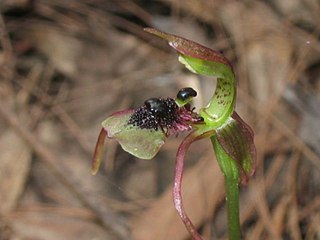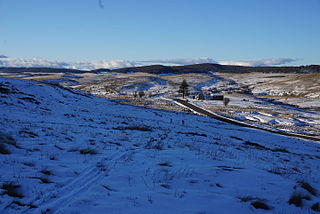Prasophyllum collinum is a species of orchid endemic to South Australia. It has a single tubular leaf and up to thirty lemon-scented, greenish brown and white flowers. It is only known from the Eyre Peninsula where it grows in sparse woodland.
Genoplesium pedersonii, commonly known as Pederson's midge orchid, is a small terrestrial orchid endemic to the Blackdown Tableland in Queensland. It has a single thin leaf fused to the flowering stem and up to thirty small, greenish red to reddish, self-pollinating flowers with a dark purplish red labellum.
Genoplesium turfosum, commonly known as the alpine midge orchid, is a small terrestrial orchid endemic to a small area in the higher parts of New South Wales. It has a single thin leaf fused to the flowering stem and up to twenty five dark purplish-red, crowded flowers with a sparsely hairy labellum.
Genoplesium validum, commonly known as the Blackdown midge orchid, is a small terrestrial orchid endemic to the Blackdown Tableland National Park in Queensland. It has a single thin leaf fused to the flowering stem and up to thirty five greenish-brown flowers with reddish stripes and a hairy labellum.
Chiloglottis anaticeps, commonly known as the duck's-head wasp orchid or bird orchid is a species of orchid endemic to the New England Tableland of New South Wales. It has two narrow leaves and a single greenish brown or reddish flower with a shiny, dark green callus occupying most of the top of the labellum. One end of the callus looks like a tiny duck's head.
Chiloglottis chlorantha, commonly known as the Wollongong bird orchid, is a species of orchid endemic to a small part of New South Wales. It has two broad leaves and a single green to yellowish green flower with about twelve reddish, yellowish or bright green glands on the labellum callus.

Chiloglottis cornuta, commonly known as the green bird orchid, is a species of orchid found in south-eastern Australia and in New Zealand including many of its offshore islands. It has two broad leaves and a single green or pinkish flower with six to eight rounded, green, reddish or blackish calli on the labellum.

Chiloglottis diphylla, commonly known as the common wasp orchid, is a species of orchid endemic to Australia. It has two broad leaves and a single narrow, greenish brown to reddish flower with a black, insect-like callus covering the upper surface of the labellum.

Chiloglottis jeanesii, commonly known as the mountain bird orchid, is a species of orchid endemic to Victoria. It has two broad leaves and a single green to dark purplish brown flower with shiny black, column-like calli on the labellum.
Chiloglottis palachila, commonly known as the spade-lipped wasp orchid, is a species of orchid endemic to some of the higher places in northern New South Wales. It has two leaves and a single green to greenish pink flower with a black, ant-like callus on the base of the labellum. The tips of the lateral sepals have distinctive swollen, brown glandular tips.
Chiloglottis × pescottiana, commonly known as the bronze bird orchid, is a species of orchid endemic to south-eastern Australia. It has two broad leaves and a single greenish bronze or purplish brown flower with a black, ant-like callus on the labellum. It is a natural hybrid formed from a cross between Chiloglottis valida and C. trapeziformis.
Chiloglottis pluricallata, commonly known as the clustered bird orchid, is a species of orchid endemic to the New England Tableland and Barrington Tops in New South Wales. It has two broad leaves and a single reddish to purplish brown flower with a callus of about six pairs of reddish to blackish glands covering two-thirds of the top of the labellum.

Chiloglottis seminuda, commonly known as the turtle orchid, is a species of orchid endemic to south-eastern New South Wales. It has two broad leaves and a single green or reddish pink flower with a shiny black insect-like callus covering two-thirds of the base of the labellum but with the tip of the labellum free of callus.
Chiloglottis sphaerula is a species of orchid endemic to a small part of New South Wales. It has two dark green leaves and a single green to reddish pink flower with a shiny black insect-like callus covering two-thirds of the base of the labellum but with the tip of the labellum free of callus.
Chiloglottis sphyrnoides, commonly known as the forest wasp orchid, is a species of orchid endemic to north-eastern New South Wales and south-eastern Queensland. It has two dark green leaves and a single green or reddish pink flower with a shiny black, insect-like callus surrounded by red club-shaped calli on two-thirds of the base of the labellum.

Chiloglottis sylvestris, commonly known as the small wasp orchid, is a small, delicate species of orchid endemic to eastern Australia. It has two dark green leaves and a single greenish pink flower with a reddish black, insect-like callus surrounded by fine, radiating, red, club-shaped calli on two-thirds of the base of the labellum.

Chiloglottis triceratops, commonly known as the three-horned bird orchid,, is a species of orchid endemic to Tasmania. It has two broad leaves and a greenish brown to purplish brown flower with a few column-like calli near the mid-line of the labellum.
Chiloglottis trullata, commonly known as the triangular orchid, is a species of orchid endemic to Queensland. It has two dark green leaves and a single small, green or pinkish flower with a shiny, dark reddish black, insect-like callus surrounded by reddish club-shaped calli covering most of the upper surface of the labellum.

Chiloglottis valida, commonly known as the large bird orchid or common bird orchid, is a species of orchid endemic to south-eastern Australia.It has two dark green leaves and a single greenish purple to purplish brown flower with six to ten blackish, column-like calli on the labellum.
Calochilus sandrae, commonly known as the brownish beard orchid, is a species of orchid endemic to the higher parts of southern New South Wales. It has a single greenish brown leaf with a reddish base and up to five brownish green flowers with red striations and a labellum with a brownish purple "beard".


















